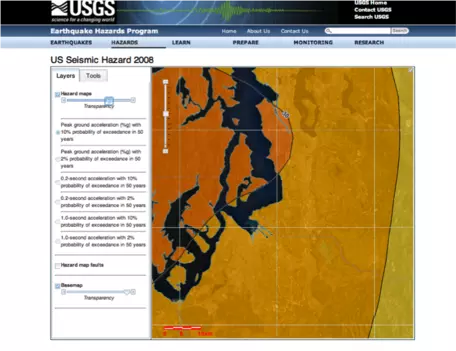Ground Shaking and Damage at Your House
Summary
In this activity, students use a seismic hazard map from the USGS to estimate the ground shaking hazard
in their community. The map shows a 10% probability of ground accelerations reaching or exceeding a certain % of gravity within the next 50 years. Students then adjust the acceleration value for the soil conditions/geologic materials that their home sits on. Once the acceleration hazard is determined, students equate that hazard to the Mercalli Intensity Scale and investigate the potential damage expected at their homes. Students also take into consideration housing types and the weaknesses inherent in different types/ages of structures.Learning Goals
Content Goals
By the end of this activity, students should be able to:
- Identify the ground shaking hazard at their house (in terms of the potential expected peak ground acceleration values).
- Determine the impact that soil type has on ground shaking values.
- Equate ground acceleration to Mercalli Intensity values to access potential impacts to their home.
- Identify probable areas of vulnerability and risk within their own home.
By the end of this activity, students should be able to:
- Navigate the interactive Seismic Hazard Map at the USGS Earthquake Hazards Program website to collect data.
- Write coherent, referenced paragraphs expressing the shaking hazard and potential response of their houses.
Higher Order Learning Goals
By the end of this activity, students should be able to:
- Synthesize the data from several different websites to evaluate the ground shaking hazard and the risk it presents to their homes.
Context for Use
This activity is appropriate for an introductory level course, however students need some prior knowledge. Prior concepts covered in lecture include ground acceleration, the Mercalli Intensity Scale, and variables that impact ground shaking and seismic intensity values. In addition, students have previously determined the type of soil/geologic materials underlaying their homes by looking at geologic maps in class.
Students do need access to a computer for the interactive map. The data gathering from the map and websites takes only 25-30 minutes and can be done in a classroom or at home. Writing the synthesis paragraphs takes a longer time and is usually completed outside the classroom as homework.
Description and Teaching Materials
Mercalli Intensity Scale (Acrobat (PDF) 123kB Apr10 14)
Grading Rubric (Acrobat (PDF) 30kB Apr11 14)
Teaching Notes and Tips
Students need internet access and a computer to collect the data and view websites. No special equipment or programs are needed; the assignment relies on data/information freely available on the web. I like to bring the Interactive USGS map up in the classroom before students begin working with it. The view of the map when you first sign on is of the complete United States and this provides an opportunity to have a class discussion about why the seismic hazard varies so much from location to location.
Assessment
References and Resources
USGS, 2012, US Seismic Hazard 2008, Earthquake Hazards Program,
http://earthquake.usgs.gov/hazards/apps/map
ABAG (Association of Bay Area Governments), 2003, Impacts of California Earthquakes on Buildings from Shaken Awake

![[creative commons]](/images/creativecommons_16.png)
